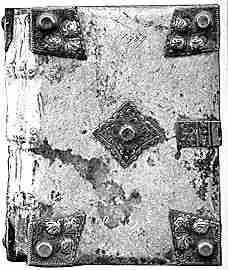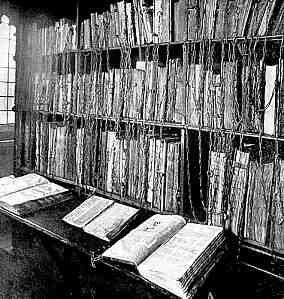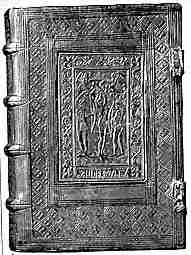 |
| Bookbindings
(2) |
 |
This
15th century binding is reinforced with hefty, but decorative, metal plates
attached to the bindings with nails, the large heads of which support the
book when it is laid out flat. The metal clasp is also visible. The metalwork,
while decorative, is also serving a practical function. |
| A
15th century bookbinding in the Bibliothèque nationale de France. |
|
The
late medieval binding at right has leather covers cold stamped with geometrical
designs. The central sections shows a scene of the martyrdom of St Sebastian.
It's a bit hard to make out, but the saint is in the middle with his hands
tied over his head while two archers stand on either side filling him full
of arrows. There would seem to be some conceptual relationship between the
development of this form of binding design and block printing of illustrated
books. |
|
|
Late
medieval stamped leather binding. |
|
Sometimes
books were additionally equipped with soft wrappers which were attached
to the binding. The book could be wrapped up when not in use. When open,
the wrappers hung down around the book like a curtain. Such arrangements
are sometimes shown in artistic depictions and may have been used to protect
the bindings of books in regular use, like books
of hours. |
|
|
These
15th century ladies kneeling at their prayer desks have books with long wrappers
dangling over the edges of the desks (British Library, MS Roy. 2 A xviii).
No, it isn't a very good reproduction. |
|
Simple
soft covers made of parchment or leather, without the solid board lining,
were also used at times for practical non-prestigious works like cartularies,
account books or books for student use. |
 |
Some
books were actually fitted with chains, so that they were permanently fastened
to their shelves. While such libraries do survive, for example at Hereford
Cathedral, there is something peculiar about this as a concept. Works of liturgy
which were used in the church could hardly be dealt with in this way. It must
be assumed that the books so treated were those residing in the library for
study purposes. As the practice is recorded and survives for monastic or cathedral
libraries, it hardly seems likely that this was literally to prevent pious
men of learning from popping a large copy of the Epistles of St Cyprian under
their cassocks and absconding. |
|
The
chained library of Hereford Cathedral, although I have discovered that this much photographed library actually dates from the 17th century, although many of the books are much older.
|
| Perhaps
it was a largely symbolic reference to the value of these works as objects,
or to visually strengthen the concept of the written words contained therein
as communal property in a true Benedictine tradition, rather than the individual
property of scholars who might wish to read them in private. As a reader of
too much Terry Pratchett, I personally find the idea that it is to prevent the
books themselves from becoming animated with the power of the words inside them
and doing erratic things beguiling, but alas, unlikely. |
|
|
Inscription
in a book (British Library, Royal 10 A xi). |
|
The
above example indicates that the chaining of books could be a matter of some
significance. The inscription indicates that the book belongs to Holy Trinity,
Chichester and was donated by William, the third bishop of Chichester. It
concludes with the instruction that the book is to be kept firmly chained
down in the college. |
|
continued |
 previous page
previous page |
 Decoration Decoration |
|
 |
 |
 |
 |
 |




